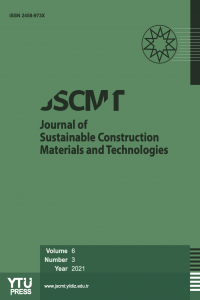The influence of microwave curing on the strength of silica fume-added fly ash-based geopolymer mortars
The influence of microwave curing on the strength of silica fume-added fly ash-based geopolymer mortars
Microwave curing, fly ash-based geopolymer, early strength, fast cure. mortar,
___
- M. S. Imbabi, C. Carrigan, and S. McKenna, "Trends and developments in green cement and concrete technology," International Journal of Sustainable Built Environment, vol. 1, no. 2, pp. 194–216, 2012, doi: 10.1016/J.IJSBE.2013.05.001.
- J. Cai, X. Li, J. Tan, and B. Vandevyvere, "Thermal and compressive behaviors of fly ash and metakaolin-based geopolymer," Journal of Building Engineering, vol. 30, p. 101307, Jul. 2020, doi: 10.1016/J.JOBE.2020.101307.
- B. Y. POLAT, M. UYSAL, and V. KORKMAZ, "A RESEARCH FOR BACTERIAL SELF-HEALING IN METAKAOLIN BASED GEOPOLYMER MORTARS," Sigma Journal of Engineering and Natural Sciences, vol. 38, no. 3, pp. 1401–1414, Oct. 2021, Accessed: May 18, 2023. [Online]. Available: https://dergipark.org.tr/en/pub/sigma/issue/65286/1007459
- B. Yılmazer Polat and M. Uysal, "Bacterial crack healing in metakaolin-based geopolymer mortars," Journal of Building Engineering, vol. 39, p. 102291, Jul. 2021, doi: 10.1016/J.JOBE.2021.102291.
- O. A. Mayhoub, E. S. A. R. Nasr, Y. Ali, and M. Kohail, "Properties of slag-based geopolymer reactive powder concrete," Ain Shams Engineering Journal, vol. 12, no. 1, pp. 99–105, Mar. 2021, doi: 10.1016/J.ASEJ.2020.08.013.
- ASTM International, Standard Specification for Coal Fly Ash and Raw or Calcined Natural Pozzolan for Use as a Mineral Admixture in Concrete. 2000, pp. 04–02.
- Çimento-Bölüm 1: “Genel Çimentolar-Bileşim, Özellikler ve Uygunluk Kriterleri.” Ankara, 2002.
- O. A. Mayhoub, A. Mohsen, Y. R. Alharbi, A. A. Abadel, A. O. Habib, and M. Kohail, "Effect of curing regimes on chloride binding capacity of geopolymer," Ain Shams Engineering Journal, vol. 12, no. 4, pp. 3659–3668, Dec. 2021, doi: 10.1016/J.ASEJ.2021.04.032.
- Z. Sun and A. Vollpracht, "Isothermal calorimetry and in-situ XRD study of the NaOH activated fly ash, metakaolin, and slag," Cem Concr Res, vol. 103, pp. 110–122, Jan. 2018, doi: 10.1016/J.CEMCONRES.2017.10.004.
- J. M. Osepchuk, "A History of Microwave Heating Applications," IEEE Trans Microw Theory Tech, vol. 32, no. 9, pp. 1200–1224, 1984, doi: 10.1109/TMTT.1984.1132831.
- T. Santos, M. A. Valente, J. Monteiro, J. Sousa, and L. C. Costa, "Electromagnetic and thermal history during microwave heating," Appl Therm Eng, vol. 31, no. 16, pp. 3255–3261, Nov. 2011, doi: 10.1016/J.APPLTHERMALENG.2011.06.006.
- Y. Esen and B. Yilmazer, "An investigation of X-ray and radioisotope energy absorption of heavyweight concrete containing barite," 2011.
- I. B. Topçu, M. U. Toprak, and D. Akdaǧ, "Determination of optimal microwave curing cycle for fly ash mortars," Canadian Journal of Civil Engineering, vol. 35, no. 4, pp. 349–357, Apr. 2008, doi: 10.1139/L07-132.
- C. K. Y. Leung and T. Pheeraphan, "PI1 SOOOS8846(97)00015-X DETERMINATION OF OPTIMAL PROCESS FOR MICROWAVE CURING OF CONCRETE," Else&r Science Ltd, vol. 27, no. 3, pp. 463–472, 1997.
- O. A. Mayhoub, E. S. A. R. Nasr, Y. Ali, and M. Kohail, "Properties of slag-based geopolymer reactive powder concrete," Ain Shams Engineering Journal, vol. 12, no. 1, pp. 99–105, Mar. 2021, doi: 10.1016/J.ASEJ.2020.08.013.
- M. KAYA, “Yüksek ve Düşük Kalsiyum İçeren Uçucu Küllerin Birlikte Kullanılması İle Üretilen Geopolimer Harçların Fiziksel ve Mekanik Özelliklerinin İncelenmesi,” Türk Doğa ve Fen Dergisi, Dec. 2020, doi: 10.46810/tdfd.782054.
- M. B. Karakoç, I. Türkmen, M. M. Maraş, F. Kantarci, R. Demirboʇa, and M. Uʇur Toprak, "Mechanical properties and setting time of ferrochrome slag based geopolymer paste and mortar," Constr Build Mater, vol. 72, pp. 283–292, Dec. 2014, doi: 10.1016/j.conbuildmat.2014.09.021.
- G. Venkatappa Rao Ch Hanumantha Rao Purnachandra Saha, "INTERNATIONAL JOURNAL OF EARTH SCIENCES AND ENGINEERING Special Issue of INTERNATIONAL CONFERENCE ON ADVANCES IN CIVIL ENGINEERING-ACE 2011 CAFET-INNOVA Technical Society Hyderabad, INDIA www.cafetinnova.org," 2011. [Online]. Available: www.cafetinnova.org
- A. Graytee, J. G. Sanjayan, and A. Nazari, "Development of a high strength fly ash-based geopolymer in a short time by using microwave curing," Ceram Int, vol. 44, no. 7, pp. 8216–8222, May 2018, doi: 10.1016/J.CERAMINT.2018.02.001.
- C. Ng, U. J. Alengaram, L. S. Wong, K. H. Mo, M. Z. Jumaat, and S. Ramesh, "A review on the microstructural study and compressive strength of geopolymer mortar, paste and concrete," Construction and Building Materials, vol. 186. Elsevier Ltd, pp. 550–576, Oct. 20, 2018. doi: 10.1016/j.conbuildmat.2018.07.075.
- G. Görhan and G. Kürklü, "The influence of the NaOH solution on the properties of the fly ash-based geopolymer mortar cured at different temperatures," Compos B Eng, vol. 58, pp. 371–377, 2014, doi: 10.1016/j.compositesb.2013.10.082.
- M. S. El-Feky, M. Kohail, A. M. El-Tair, and M. I. Serag, "Effect of microwave curing as compared with conventional regimes on the performance of alkali activated slag pastes," Constr Build Mater, vol. 233, Feb. 2020, doi: 10.1016/j.conbuildmat.2019.117268.
- P. Chindaprasirt, U. Rattanasak, and S. Taebuanhuad, "Role of microwave radiation in curing the fly ash geopolymer," 2013, doi: 10.1016/j.apt.2012.12.005.
- A. Celik, K. Yilmaz, O. Canpolat, M. M. Al-mashhadani, Y. Aygörmez, and M. Uysal, "High-temperature behavior and mechanical characteristics of boron waste additive metakaolin based geopolymer composites reinforced with synthetic fibers," Constr Build Mater, vol. 187, pp. 1190–1203, Oct. 2018, doi: 10.1016/j.conbuildmat.2018.08.062.
- M. Uysal, M. M. Al-mashhadani, Y. Aygörmez, and O. Canpolat, "Effect of using colemanite waste and silica fume as partial replacement on the performance of metakaolin-based geopolymer mortars," Constr Build Mater, vol. 176, pp. 271–282, Jul. 2018, doi: 10.1016/j.conbuildmat.2018.05.034.
- M. Sivasakthi, R. Jeyalakshmi, N. P. Rajamane, and R. Jose, "Thermal and structural micro analysis of micro silica blended fly ash based geopolymer composites," J Non-Cryst Solids, vol. 499, pp. 117–130, Nov. 2018, doi: 10.1016/j.jnoncrysol.2018.07.027.
- Başlangıç: 2016
- Yayıncı: Yıldız Teknik Üniversitesi
Performance of Superabsorbent Polymer as Admixture in Hollow Concrete Blocks
Phoebe Love CANDANO, Kate Rose ELORDE, Irl Rica Ann MEJOS, Rhoe James CABADA, Val Irvin MABAYO
Hussaini MATO, Yahaya Hassan LABARAN, Dipanjan MUKHERJEE, Gaurav SAİNİ, Mahmoud Murtala FAROUQ
Assessment of a new rigid wall permeameter for the slurry like barrier materials: zeolite example
Oluwafemi AKANDE, Chioma EMECHEBE, Jonam LEMBİ, Joy NWOKORİE
Şevket Onur KALKAN, Lütfullah GÜNDÜZ
Mechanical behavior of large-diameter pipe elbows under low-cyclic loading
An architectural query of Anthropocene Era: Planned obsolescence
